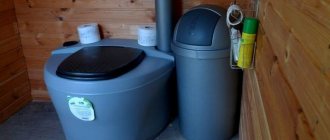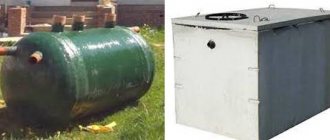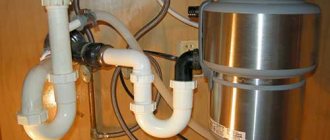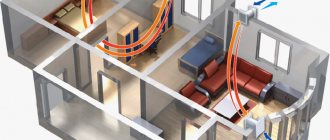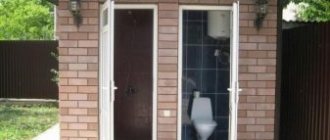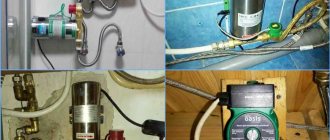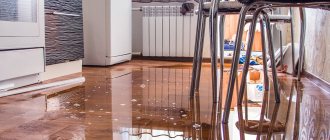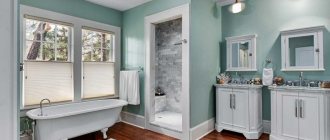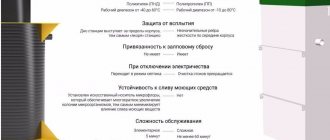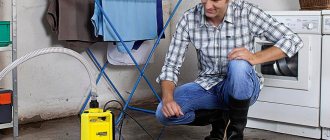How to make a peat dry closet for your dacha?
A dry closet is a device without which it is difficult to imagine comfortable country life today.
Choosing the optimal dry closet that would justify the investment in it and, at the same time, does not require long-term cleaning and excessive attention to yourself is a troublesome task . We recommend that you pay attention to the peat dry closet for your dacha. What is its advantage?
Peat dry toilet for a summer residence
Peat for dry toilet
The dry toilet differs from conventional models in that in the compartment where liquid is poured, in this type of toilet finely ground peat is poured. The peat tank has a handle, by rotating which its contents are scattered. In order to get rid of the unpleasant odor of the contents of the toilet, after using it, you need to twist the handle, due to which peat will fall into the tank, thereby removing all unpleasant odors.
Separately, it is worth noting the fact that peat tends to absorb the liquid part of human waste; the same part of the liquid that the peat does not contain is transferred to the lower compartment of the toilet, equipped with a tray. A hose is drawn from this pan, which drains excess liquid outside into a cesspool.
That part of the waste that has a solid base is processed by special bacteria that inhabit peat. At the end of this process, a virtually odorless mixture remains, which can easily be sent to the compost heap. True, such waste can be used for fertilizer no earlier than after a year or even two.
The peat dry closet includes the following structures:
- directly the dry closet itself,
- liquid tray,
- a pipe necessary for ventilation, made of plastic (most often about two meters long), or an exhaust fan.
Advantages of installing a peat dry closet at your own dacha:
- Due to bacteria acting on waste, the reservoir of such a toilet takes quite a long time to fill. If three people permanently live at the dacha, the tank will have to be cleaned no earlier than after three months,
- very little peat is consumed to use such a dry toilet, and its price is quite low,
- simplicity of disposal measures: the output is a brown substance that does not have a specific appearance or unpleasant odor. It can be placed on a compost heap, after which it can be quite easily leveled with a rake. After two weeks, this mass will be difficult to see; most likely, it will already be overgrown with grass.
If the ventilation in a peat toilet works properly, it has absolutely no odor. A peat dry closet can be installed not only in a special room, but even at the dacha itself. If the structure is made of frost-resistant plastic, it can be safely left outside for the winter.
Disadvantages of a peat toilet
It would be fair to highlight several disadvantages of peat dry closets. Firstly, the not very uniform process of spreading peat requires certain skills. Quite often there are cases when you have to manually sprinkle waste with peat. Secondly, the hose for draining liquid waste is located at a high level, which allows a large amount of waste to accumulate, which can result in an unpleasant odor. It is quite difficult to take a container filled with waste to the compost heap on your own due to its heavy weight.
The peat toilet must be operated with the fan running, especially if it is located right in the country house. This is a stationary, not a mobile device, so moving it to a new location may cause some difficulties. A peat dry toilet for a summer residence is an excellent solution for those who want to feel comfortable under any circumstances.
How to make a peat dry closet for your dacha? We recommend paying attention to a peat dry closet for your dacha. What is its advantage? The dry toilet differs from conventional models in that the compartment where the latter is filled with liquid, in this type of toilet, finely ground peat is poured
Video description
The peat portable toilet is described in the following video:
On a note! When cleaning a dry closet, peat along with waste is poured into a compost pit. Here the mixture produces an environmentally friendly fertilizer for garden beds. As a result, site owners are given the opportunity to install a zero-waste structure.
The advantages of peat portable toilets include:
- no need to use water;
- the ability to not empty the waste container for a longer period compared to liquid devices;
- lower price than the cost of liquid-type structures.
However, peat models also have disadvantages that need to be taken into account. This is the inability to completely neutralize the unpleasant odor and the need for a permanent installation. In addition, it is necessary to arrange a place on the site where the mixture of peat and waste will be stored.
Stationary peat dry closet Source promtu.ru
DIY liquid for dry toilet
Compositions for the bathroom cost a lot; in extreme cases, you can make them yourself. For this you will need:
- Vinegar
– eliminates unpleasant stench and has an antibacterial effect. - Salt
– absorbs dirt. - Essential oil
– gives a deodorizing effect. - Starch
is a binding component.
How to prepare liquid for a composting toilet yourself:
- Mix 1 part salt and 3 parts starch.
- Pour 100 ml of water for every 100 g of dry mixture.
- Mix the composition until a homogeneous mass is formed.
- Heat the mixture over heat, stirring until it thickens.
- After the mixture has sizzled, it needs to be heated for another half a minute.
- After cooling, add vinegar to the antiseptic - 8 ml for every 100 g of mixture and essential oil - 3 drops for every 100 g of mixture.
- The composition for the tank is ready, you can pour liquid soap into it, it will increase its cleaning properties. The validity period of a homemade consumable is 1-2 weeks. In terms of effectiveness, the composition is inferior to professional products, but in case of its absence it will do its job well.
Cleaning yourself
If the dry closet is a portable home device, you can wash it yourself.
There is a folk recipe for eliminating unpleasant odors from dry closets:
- Pour 70 g of starch into a small plate.
- Add 25 g salt.
- Pour 100 g of cold water here.
- Mix everything.
- Place the resulting mixture on the stove and stir over low heat for 10 minutes (until lumps form).
- After 1 minute, add 15 mg of vinegar and a few drops of essential oils.
- Continue stirring everything and add some soap shavings.
- Then pour the finished mixture into the drain tank.
There are different types of litter you can use to clean your portable toilet. Their choice will depend on where you plan to discharge waste from the dry closet.
Options for stationary structures
All variants of dry toilets that are sold on the modern market are divided into three areas:
- Liquid dry toilet. Is a more expensive option. This toilet runs on a special biologically active liquid. This liquid is quite expensive, and a container is also needed to transport this liquid.
- Electric dry closets. This system is based on the rapid drying of waste. This happens in a closed chamber under a hot air stream, where biological waste is dehydrated and significantly loses its volume. These types of toilets can last a very long time, but these toilets consume a lot of electricity and this will clearly affect your budget.
- Peat toilet. It is the most budget option for a summer residence.
When choosing a factory model, you need to consider some nuances:
The dimensions of a purchased dry toilet must be selected to match the average size of a standard toilet. But this device must be brought to the dacha; Having a tank full indicator will help you a lot
Thanks to it, you will clearly know when to replace the absorbent or specialized liquid; The capacity of the working tank must be taken into account; It is necessary to pay attention to the maximum permissible load, since the containers are made mainly of plastic.
Nowadays, it is possible to purchase the cheapest and simplest toilet. The simplest design is a folding frame onto which a garbage bag is placed and secured. After the toilet has been used, cat litter absorbent or peat is poured into the bag. But this option is not very good to use.
Everyone wants to live in comfort and therefore many are trying to replace the long-outdated wooden toilet with more modern options. Of course, if it is a good brick toilet that is equipped with a cesspool, then you can leave it. But it is still better to replace a wooden toilet with a composting toilet.
This toilet is convenient, environmentally friendly, and produces high-quality fertilizers. The composting toilet has positive reviews, so it’s worth making it yourself or buying it ready-made. For this reason, many summer residents decided to equip such a composting toilet. You can make a composting toilet yourself or purchase it ready-made.
What it is
Let's look at what a dry closet looks like for a house without a sewer system. Externally, this is a compact set that includes a toilet bowl, a container on which it is installed and a unit that performs the function of a flush cistern. Most models work autonomously, but there are universal or combined designs. A special feature of the device is biological or chemical waste disposal. In addition, there was a complete absence of the bad smell characteristic of ordinary cesspools.
A dry toilet does not solve the problem of drainage from plumbing. It is intended for the reception and treatment of physiological waste only. To drain liquids from other devices, you will need a separate, independent line. This is a feature of the dry closet, which must be taken into account when choosing a method of waste disposal.
The design of most devices resembles the usual design of a floor-mounted compact toilet, only instead of connecting to the drainage line, there is a container for collecting and processing waste in the lower part. It deodorizes and utilizes organic matter. This is how all indoor dry toilets are designed and do not require sewerage. There are more complex designs that can simultaneously operate autonomously and connected to the system. As a rule, the choice of a particular device is determined by several criteria:
- expected working conditions;
- amount of waste;
- container cleaning frequency;
- availability of electricity and running water in the house;
- financial capabilities of the user.
As a rule, any indoor dry toilet without sewerage is not fundamentally different from the street stalls familiar to all city residents. It is not equipped only with outer walls, and the device itself functions in the same way. It will not be able to become a full-fledged alternative to the central sewer system, but it effectively solves the problem of waste disposal.
Principle of operation
A portable dry toilet is a fairly simple design. After purchase, it will have to be assembled and prepared for use. Assembly consists of connecting individual parts, commissioning involves filling the tanks with water and liquid for dry closets.
To use it for its intended purpose, you need to choose a place, place it, fill it with water and a special liquid. Through a special hole, a reagent is poured into the lower container, which is responsible for the breakdown of feces.
After which a little water is added there and the top one is placed on it. The upper part is fixed with latches and filled with water for flushing, to which a liquid can also be added, but with aromatizing effect. At this point, the installation is complete and you can use it.
Once in the lower tank, the fecal matter is decomposed by a chemical reagent. This drug deodorizes and breaks down waste into a liquid state. At the same time, the process of gas formation stops and the toilet smells only of aromatized liquid.
After the storage tank is filled, it must be emptied. To do this, you need to disconnect the upper part, and take the lower part by the handle to the disposal site and pour the sewage through a special hole. Then, the tank is rinsed with water, filled and installed in place.
Standard design of a sewerage pumping station TP 902-1-70-83 NK
The depth of the inlet manifold is from 4 to 7 m.
The number of pumping units is three (including one reserve).
Brands of pumping units - SD 100/40, SD 160/45, FG 144/46, FG 144/10.5 or FG 450/57.
The supply manifold passes through a shutdown chamber in which the valves are located, as well as an emergency release device.
The underground part of the structure is made of reinforced concrete. It is a well of circular cross-section. The ground part is built of brick and has a rectangular shape.
The tank capacity is 45 m3. This volume of liquid can be pumped in 12 minutes using the SD 100/40 pump unit, in 8 minutes using the SD 160/45 pump, or in 5 minutes using the FG 450/57 pump. The bottom of the receiving tank is made with a slope of 0.1 in the direction of the pit in which the suction pipes are mounted.
To separate large suspended contaminants from wastewater, the system is equipped with filter grids. 2 crusher gratings RD-600 or crushing gratings KRD-40 are installed in the room. In this case, one of the gratings is in operation, the other is in reserve. Suspended particles coming with wastewater are retained on the grate (16 mm gap). To clean the grate, a rotating comb is used, with the help of which debris from the grate is raked into the crusher pit. The waste crushed in the crusher is returned to the wastewater and passes through the grate into the receiving tank. During the repair period, it is possible to install a backup grille.
Pumping units are located in the machine room. The pumps are installed under the bay. To install the unit, a cast iron plate is used, on which the electric motor and pump are mounted. The plate is included in the delivery package of the pump unit.
Check valves are installed on the discharge pipelines. This prevents pumped wastewater from the discharge line from flowing back into the receiving tank after the pump is turned off.
Water from the floor of the engine room is drained by a system of trays into a pit, from where it is transferred to the receiving tank by the GNOM pump. The pump is switched on automatically when the top level of the pit is reached, based on a signal from the level sensor.
Electromagnetic flow meters are used to measure liquid flow. Installation of flow meters is provided on each pressure pipeline.
To carry out repair and installation work, lifting and moving station equipment, a lifting device is installed in the grating room and in the engine room - a monorail with a mobile suspended manual hoist with a lifting capacity of one ton.
The project provides for the installation of drinking and industrial water supply systems. The exhaust ventilation systems provided for the machine room and the receiving tank are designed separately.
In the ground part there are living quarters for staff - a rest room, a bathroom, a shower.
To move cargo during installation or repair work, to move equipment outside the station, an overhead crane beam, a monorail and a manual hoist are used.
Features of the instructions for use
One package contains 75 grams of product, which is enough for a month for septic tanks with a volume of 1500 liters. How to use the product:
1.The powder is poured into the toilet and flushed in several stages.
2. The powder can be immediately added to the septic tank.
3. The package with the product is diluted in a warm liquid, the solution is poured into the pit.
The use of the product depends on the frequency of use of the cleaning system. The funds last for 30-45 days. The use of the product is safe for people and plants. Medicines should be kept away from children.
Preparation for cesspools
You should use a product marked 209. Accelerates the formation of compost and contains special soil bacteria. Dr. Robik is able to break down any organic substance in a short time. As a result, a compost mass is formed, useful for any soil.
Mode of application. When using the product every 30 days, you must adhere to the rules. First of all, add warm water to the compost, then:
1.Pour the dry mixture on top of the wet compost.
2.A layer of soil from the garden is poured onto the compost powder.
3. Mix the powder and primer well.
One package can satisfy the processing needs of 1.5 m2. The product is environmentally friendly and does not harm nature or humans.
With regular care using the product
Product marked 309
It is used in septic tanks and drainage systems. Serves to protect the sewer system from breakdowns, prevents the appearance of odors, and fights blockages. The bottle has a volume of 0.798 liters, it is enough for use for a whole year for septic tanks measuring 2000 liters.
Attention! Doctor Robik 309 does not contain chemicals that are dangerous to others. Means for a standard or storage sewer system
Means for a standard or storage sewer system
For a storage type of sewer system, you need to use Doctor Robik 409. It contains highly effective enzymes, they guarantee the uninterrupted operation of the sewer system all year round. Using the product increases the period between when waste pumping is required and kills unpleasant odors.
Features of application. The 0.798 l bottle is designed for a capacity of 2 cubic meters. When filling the bottle once, the filling level decreases. Different ways to use:
1.Before filling the product, shake the bottle. Next, pour the contents into the toilet. Drain the water.
2.You can pour the bottle directly into the cesspool.
If the septic tank has old deposits, then the help of Doctor Robik 509 is required; when washing the container, marking 809 is used. Once a year, sewage waste should be pumped out and then filled with 409.
Impact cleaner
The product marked 509 is used for cesspools, septic tanks, drainage, which are filled with a thick mass of sewage, including fossils. The drug is excellent for use in old sewer septic tanks with problems in drainage systems.
Features of application. The bottle is designed for a capacity of 2 thousand liters. Add the product immediately after pumping out the contents and flushing the system. Add the product once a year when necessary.
Attention! You can regularly use Doctor Robik 109, 309, 409
Soap solution
Dr. Robik marked 809 can be used to clean all types of sewers from soap solutions and cleaning products. These substances are converted into safe elements. The product consists of lipases and proteases, which accelerate the decomposition of harmful substances. The bacteria included in the composition with enzymes destroy soap, foam, growths on pipes, on the walls of the septic tank, and pits.
Features of application. The product should be poured into the sewer once a year. The bottle is enough for a septic tank volume of 2 thousand liters. The drug is often used as an additional product to markings 309 and 409. Before filling, the bottle is shaken and poured into the toilet or directly into the septic tank. The water used is reduced in volume on the first day. The product does not contain harmful substances. For it to be effective, once a year it is necessary to pump out the sewerage and flush the system with water.
How to choose the right option?
The dry closet must be selected taking into account the conditions of its operation. You should consider where the sanitary system will be installed, whether it needs to be portable or whether a stationary model is suitable
It is important to decide on the type of unit - the installation method and maintenance requirements depend on this
Features of different dry toilets
There are three types of autonomous toilets on the market: chemical, peat, mechanical and electric. Which of the dry closets is better is easier to decide by comparison.
The first type is often called liquid. It consists of two tanks. The upper container contains water for flushing, the lower container contains storage containers. Waste is dissolved by chemical liquids. The storage tank has a valve that prevents the spread of unpleasant odors.
The advantages of chemical toilets: complete autonomy, mobility, compactness and light weight. The installation does not require ventilation, the unit absorbs odors.
Disadvantages of liquid systems:
- toxicity - if ammonium or formaldehyde solvents are used as reagents;
- expenses for purchasing chemicals;
- the need to frequently empty the tank;
- acrid smell of chemical reagents.
A peat biotoilet is most often chosen by summer residents. The design is two-section - at the top there is a seat and a compartment for peat, at the bottom there is a storage tank. The volume of the lower tank varies between 40-120 liters.
Installation of a dry closet is possible in a house or outdoor cabin, operation is year-round. The system does not provide a water drain; the waste is covered with peat
Before purchasing, it is generally important to find out in advance how to clean a dry closet. It is possible that any of the methods for emptying the storage tank simply will not suit you
Pros of a composter toilet:
- fertilizer production, environmental friendliness;
- there is no need to frequently empty the tank;
- availability of consumables – peat mixture.
Disadvantages of composting units: poor cleaning of the dry closet due to the lack of water drainage, the need to remove the drainage pipe and connect the ventilation duct. A peat toilet is difficult to move; a permanent place must be allocated for it.
Electric dry closets are advanced sanitation systems. The waste is dried in the storage tank, which allows you to use the toilet for a very long time (about 4-6 months) without emptying the container. Liquid sewage is discharged through the drainage channel.
The main advantages: absence of odors, simplicity and infrequency of cleaning. Disadvantages include dependence on electricity and high cost.
Accounting for operational parameters
After determining the type of dry closet, it is necessary to compare the parameters of models of this type.
It is worth considering the following characteristics:
- Volume of storage container. The capacity of the tank should be compared with the number of regular users, as well as the frequency of operation of the dry closet. For permanent use, it is better to choose a model with a large tank.
- Seat height. The seat height of a standard toilet is 40-45 cm. From an ergonomic point of view, this height is the most comfortable.
- Dimensions. For permanent installation in a house or outdoor building, you can choose large models. If you plan to transport the dry closet, move it from place to place, then portable products are suitable.
- Material of manufacture. The body is usually made of polypropylene, polystyrene or polyethylene. If the dry closet will be used in winter in an unheated room, then it is better to discard the latter material.
It is important to clarify the maximum possible load on the equipment, the average is 120-150 kg. You should focus on the weight of the largest family member
For ease of unloading and carrying, the storage tank must be equipped with reliable handles and wheels for transportation.
What to pay attention to
When buying a dry closet for an apartment without a sewer system, you must first consider its functionality. Required options:
- flush unit. The most effective models are those with double-sided flushing, where the entire area of the bowl is completely washed;
- pressure valve. Eliminates water splashing;
- storage tank loading indicator, notifying about cleaning time;
- storage volume. The more people use the dry closet, the larger the tank is needed;
- dimensions. It is necessary to think in advance whether it will have to be transported in a car, or installed in a cramped room;
- connection to the sewerage system in the house.
A controversial type of design has become a dry closet with a sewer connection. If it exists, it is easier to build a normal bathroom and not use intermediate devices. However, many owners use this method to reduce the volume of wastewater in a septic tank or cesspool. This allows you to increase the interval between pumping out the tank.
Characteristics and types
The flexible hose for connecting plumbing is a hose of different lengths made of non-toxic synthetic rubber. Thanks to the elasticity and softness of the material, it easily takes the desired position and allows installation in hard-to-reach places. To protect the flexible hose, there is an upper reinforcing layer in the form of a braid, which is made from the following materials:
- Aluminum. Such models can withstand no more than +80 °C and retain functionality for 3 years. At high humidity, aluminum braiding is prone to rust.
- Of stainless steel. Thanks to this reinforcing layer, the service life of the flexible water line is at least 10 years, and the maximum temperature of the transported medium is +95 °C.
- Nylon. This braid is used for the manufacture of reinforced models that can withstand temperatures up to +110 °C and are designed for intensive use for 15 years.
The fasteners used are nut-nut and nut-fitting pairs, which are made of brass or stainless steel. Devices with different permissible temperatures differ in the color of the braid. Blue ones are used to connect to a pipeline with cold water, and red ones for hot water.
When choosing a water line, you need to pay attention to its elasticity, reliability of fasteners and purpose. It is also mandatory to have a certificate that prevents the rubber from releasing toxic components during operation.
Choosing a toilet for a summer residence
It is necessary to choose a dry closet based on its characteristics and parameters, as well as the affordability of the cost of purchasing it. The main parameters that you should focus on when choosing a product are:
Drainage connection diagram
- capacity of the lower storage tank for sewage;
- volume of the upper peat tank (if it is included in the design);
- the height of the toilet seat, which should be consistent with the average height of family members;
- the weight of the structure and the tank itself, which must be transported to the compost heap;
- comfort of use, seating comfort, material from which it is made;
- the strength of the material from which the product is made and the maximum load on it;
- presence of a fill indicator and an overpressure release button;
- the presence of a mechanical peat mixture dispenser or the need to add it manually.
For a family of 2-3 people, a tank for accumulating sewage with a volume of up to 60 liters is suitable, and for a larger family, a container with a capacity of at least 110 liters is needed, it is designed for 200 uses and may not be cleaned for 1.5 to 3 months, depending on number of users.
A high-quality Finnish dry toilet can withstand a wide range of annual temperature fluctuations and can be used all year round. You should avoid fakes made from inexpensive, fragile material that quickly deteriorates and may not withstand the load stated in the instructions.
Brass fittings for HDPE pipes
Brass HDPE pipe fittings are used to assemble water pipes. Available in two types:
- Brass compression fittings for HDPE pipes. They are characterized by a maximum operating temperature of 40C. If the ambient temperature is higher, it is recommended to use a different coupling.
- Brass threaded fittings. They are used for pipes of different diameters and in places where it is required to change the direction of flow. There are designs with a transition to an internal thread from an external one.
The design has increased strength.
